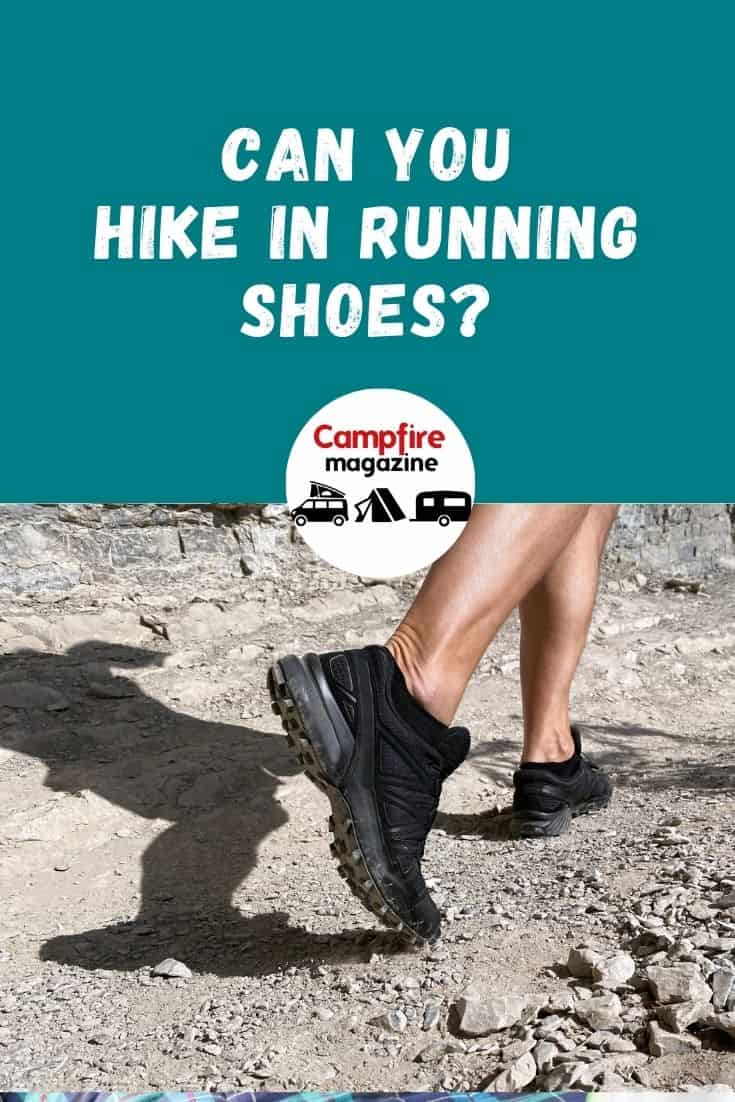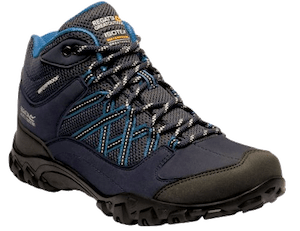You’re ready to hit the trails but upon inspecting your hiking boots, you notice that they’re not quite up to standard. There’s no time to head to the shops to buy a new pair, so is there anything else you can put on your feet? Yes! Your running shoes; they’ll be OK, won’t they? Can you hike in running shoes?
The truth is that it is more than possible to use your running shoes for hiking. In fact, while there is a lot of debate on the subject around the internet, many would agree that ditching your hiking boots and going for trail runners is an excellent idea.
Of course, it pays to keep in mind that not all running shoes are made equal so you will need to ensure that your specific pair is up for the challenge. One of the key things to look out for is whether your runners are road running shoes or trail running shoes. In this guide, we’ll cover this and much more telling you all you need to know about hiking in running shoes.

Can I Use My Running Shoes For Hiking?
The short answer to this question is yes, you can. However, since there are different types of running shoes, you will need to make sure that you have trail runners if you want them to give you everything you need when hiking rugged trails.
The truth is that you can really hike in any kind of footwear you like; not all of it will be protective and supportive so that’s something to keep in mind. But whether your old hiking boots have had it or you just want something a little more lightweight, trail runners offer a great alternative to the traditional hiking boot.

Hiking Boots vs Running Shoes
Before we start talking about how wonderful trail running shoes are when it comes to hiking, we must point out that the humble hiking boot is the obvious choice since it is perfectly designed for this type of activity. These are incredibly strong boots that are designed to stand the test of time, even when you’re navigating rough or rugged terrain.
Hiking boots are also designed to limit the pressure on your joints and absorb shock when walking over uneven ground. But they still offer a good degree of flexibility; you could say that they give the best of everything.
You’ll notice that the soles of your hiking boots have a very deep lug pattern and are made from solid rubber, giving you great traction regardless of the conditions. But despite this, modern hiking boots are also very lightweight and so don’t make you feel as though you’re wearing a couple of breezeblocks on the ends of your legs.
One of the most obvious benefits of the hiking boot is that most are waterproof and so are ideal for going out in all conditions and types of weather. The downside to this, of course, is that this makes the boots far less breathable so the feet can get hot, sweat can build up and this can cause the boots to chafe. But then, there are some that are vented which does go a long way in eliminating this problem.
On the other hand, most running shoes are totally different to the hiking boot which is why a lot of people would consider them to not be suitable for this type of activity. They are very lightweight and offer superior breathability. After all; they’re designed for running which is a very high-intensity activity.
However, while they’re great for this, some styles aren’t built for the demands and challenges of rugged terrain since the materials are not as robust. This means that, if you use your trail running shoes for hiking, you’ll probably end up replacing them more frequently.
You’ll find that most running shoes have a decent tread on the sole but this isn’t quite up to the same standard as hiking boots. That said, unless you’re planning on scaling Everest, your trail runners should have enough traction to withstand a variety of conditions and keep you stable. The only real problem is that the sole and midsole might not be able to absorb shock as effectively.
With all this in mind, it’s easy to see why running shoes could be a viable replacement for your hiking boots, provided that you’re not going on a Bear Grylls style adventure. For your casual weekend hike; go right ahead.
Reasons Why You Should Ditch Your Hiking Boots?
Now that we understand how running shoes compare to hiking boots, you might be considering making the switch. However, if you need a little more convincing then let us share some helpful insights with you.
Feel Less Weighty
While a lot of modern manufacturers are making leaps to ensure that hiking boots are not as clunky and cumbersome as they once were, there’s no getting away from the fact that they are heavier than trail running shoes. This is because of the materials from which they are made (leather with solid rubber soles.) When you’re out exploring the trails, you need to have as little weight as possible as the more you have, the more energy you expend.
What a lot of people don’t realise is that carrying weight on your feet can fatigue you much more quickly than if you were carrying, say, on your back. It can use up between four and six times more energy so switching to a lightweight running shoe could mean you are able to complete that trail you’ve been trying to conquer more easily.
Stop Blisters In Their Tracks
Have you ever been in the middle of a lengthy hike only to feel the pain of a blister beginning to develop? There is nothing more painful and nothing that can make a mile feel like ten than a blister. But those who wear hiking boots will know that this is a common complaint.
One of the main reasons that blisters are an issue for hikers is that the boots are so rigid they aren’t as easily able to flex when the feet move. Plus, as we mentioned earlier, the lack of breathability means that moisture will build up much more quickly which can cause your hiking boots to rub.
You might think that breaking your boots in will reduce this issue and it will, to an extent but wearing a good pair of trail running shoes will eliminate the problem pretty much entirely.
It’s also important to keep in mind that, while your hiking boots will be advertised as being waterproof, that doesn’t mean the feet won’t get wet. Yes, you’ll have adequate protection from external factors like rain or walking through a ford but internally, that sweat build up is still going to be a problem.

Do Your Ankles Really Need All That Support?
One of the things that hiking boot manufacturers will shove in your face is that their boots offer superior ankle support. This is true to an extent and the high top design and rigidness will keep those ankles in place and prevent you from having a nasty twist. However, it might not be all it’s cracked up to be.
There has been a lot of research into the benefits of hiking boots in terms of ankle support and while there is a degree of it, protecting those delicate joints is more about how you take care of them. For example, you’ll be far less likely to sustain an injury by regular strengthening exercises and stretching before going on a long hike. Do this, and wearing running shoes will see you with just as much protection.
It’s also worth thinking about the fact that the added weight of your hiking boots will tire out the legs more easily which could result in clumsy footwork; and that’s a shortcut to sustaining a foot or ankle injury.
Get Out And Explore More Quickly
One of the biggest problems with hiking boots is that you have to break them in. You can’t simply buy a new pair, whack them on and head out to your favourite hiking spot. Do this and those mid-hike blisters we talked about will be the least of your worries. So, before you can go and explore the great outdoors, you’ll have to spend time breaking the boots in. That isn’t the case with trail runners.
Moreover, you will need to keep in mind that hiking boots cost a lot more and they require much more maintenance than running shoes. You’ll need to ensure that they keep their form and remember to reproof them so they continue to keep your tootsies dry. Being able to buy a pair of comfortable trail running shoes and wear them straight out of the box is amazing.
The Importance Of using Trail Running Shoes
We have mentioned that you cannot simply wear any kind of running shoes when hitting the hiking trails. Shoes designed for road running on concrete and flat surfaces will not offer the right kind of comfort, support or protection to the feet so right off the bat, we would say do not use these. Instead, always opt for trail running shoes, and here’s why.
- Trail running shoes have far greater grip than their road running counterparts making them suitable for the demanding terrain you will find on the hiking trails. If you use road running shoes in these conditions, you will find that the minimal tread will wear down very quickly making them slippery and almost impossible to hike in safely.
- Road running shoes assume that the wearer isn’t going to be in any serious danger when it comes to hurting their toes so there isn’t much in the way of toe protection. On the other hand, trail running shoes are equipped with a toe guard which, while it might not be as robust as those found on hiking boots, it will offer greater protection on rugged ground
- Trail runners are designed for well, running on trails, so manufacturers know that the conditions will be a little more testing. For this reason, these shoes are designed to withstand a certain amount of rough use and testing weather conditions whereas road running shoes simply aren’t cut out for this wild way of life.
- There are some trail running shoes that have a high top which is excellent when hitting the trails as this prevents small pieces of debris from being kicked up into your shoe. You won’t find this feature on road running shoes and there is nothing more annoying than having to repeatedly stop because of a stone in your shoe.
Conclusion
Trail running shoes are a good alternative to hiking boots for many reasons. They offer much of the same protection and have many of the same features but without the bulky design. However, it is important to keep in mind that you shouldn’t replace your hiking boots with running shoes that are designed to be used on concrete as these won’t have suitable features and will likely be uncomfortable and unprotective.
OUR TOP PICK
My choice from Regatta is the Edgepoint hiking boot, for both men and women.
A good choice if you want to avoid suede and leather (even on trims). However, we’ve heard from a disappointed reader who found these weren’t as waterproof as she’d hoped. Regatta say they’re water repellent.
A super boot for the price, with good grips and support. They weigh less than 400g too. You might want to go up half a size to accommodate socks or an insole.
Masses of other styles to choose from and often some bargains to be had.



